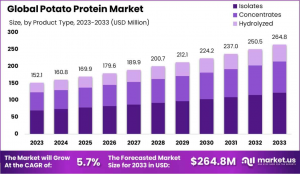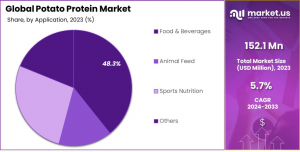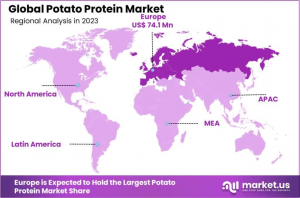Potato Protein Market is expected to be worth around USD 264.8 Million by 2033, up from USD 152.1 Million in 2023, at a CAGR of 5.7% from 2024 to 2033.
Europe holds a 48.1% share in the potato protein market, valued at USD 74.1 million.”
NEW YORK, NY, UNITED STATES, January 23, 2025 /EINPresswire.com/ -- The global potato protein market is witnessing substantial growth, driven by various factors that underscore its importance in the current industrial landscape. Potato protein, extracted through the processing of potatoes, is gaining prominence due to its high-quality protein content which offers a viable alternative to animal proteins. The focus on sustainability and the shift towards plant-based diets have further bolstered the demand for potato protein in recent years.— Tajammul Pangarkar
The Driving Factors for potato protein is driven by several key factors. The rise in veganism and vegetarianism worldwide has created a substantial demand for plant-based proteins. Potato protein is particularly appealing due to its allergen-free attribute, making it a preferred choice for consumers with dietary restrictions. Furthermore, its functional properties such as emulsification, texturing, and water-binding capabilities make it ideal for use in a wide range of food products, from baked goods to meat alternatives.
The demand for potato protein is also influenced by the growing fitness and wellness industry. As consumers become more health-conscious, the inclination towards dietary supplements enriched with natural proteins has seen a significant rise. Additionally, the expanding global population and the rising need for sustainable food production methods are compelling food manufacturers to seek out alternative proteins that minimize environmental impact, thereby propelling the market growth of potato proteins.
Technological advancements have played a crucial role in refining the extraction and processing techniques of potato protein. Modern technologies enable more efficient separation of protein from potato juice, resulting in higher yields and better quality of the final product. Innovations in enzymatic hydrolysis and membrane filtration have further enhanced the functionality and purity of potato proteins, making them more suitable for a variety of applications.
Future growth opportunities for the potato protein market are abundant. Innovation in extraction and processing technologies may lead to more cost-effective production methods, broadening its accessibility and application. The ongoing trend towards clean-label products, where consumers favor ingredients with transparent sourcing and minimal processing, presents a lucrative avenue for potato protein. Its application in sports nutrition as a high-quality protein source that supports muscle repair and growth could open new segments for market expansion.
For a deeper understanding, click on the Free sample report link: https://market.us/report/potato-protein-market/free-sample/
Key Takeaways
◘ The Global Potato Protein Market is expected to be worth around USD 264.8 Million by 2033, up from USD 152.1 Million in 2023, and grow at a CAGR of 5.7% from 2024 to 2033.
◘ The Potato Protein Market sees isolates leading product types with a significant 46.2% market share.
◘ Conventional potato protein dominates, capturing 73.1% of the market by nature, preferred for its availability.
◘ In applications, food and beverages incorporate potato protein most, holding a 48.3% slice of the market.
◘ Commercial users are the primary end users, utilizing 66.1% of potato protein in various industries.
◘ The majority of potato protein sales occur offline, with physical stores commanding a 68.1% market share.
◘ Europe holds a 48.1% share in the potato protein market, USD 74.1 million.
Potato Protein Top Trends
1. Innovation in Extraction Technologies. There's a significant focus on developing new extraction methods to increase potato protein yield and reduce energy consumption. Innovations in this area are crucial for enhancing the viability and cost-efficiency of potato protein production.
2. Expansion in Application Areas. Potato protein is finding new applications beyond traditional food products. It's increasingly used in sports nutrition, functional foods, and as an ingredient in plant-based meat alternatives, reflecting its growing versatility and consumer acceptance.
3. Sustainability Initiatives. Companies are emphasizing sustainability in their production processes. Potato protein is seen as a more environmentally friendly alternative to animal-based proteins, aligning with global efforts to reduce carbon footprints and conserve resources.
4. Strategic Partnerships and Investments. There's a trend toward forming strategic alliances and increasing investment in the potato protein sector. These partnerships are aimed at boosting product innovation and expanding market reach, particularly in regions where plant-based diets are becoming more popular.
5. Focus on Non-GMO and Allergen-Free Products. As consumer demand for clean-label products grows, potato protein manufacturers are focusing on non-GMO and allergen-free formulations, which are crucial for catering to health-conscious consumers and those with dietary restrictions.
Key Market Segments
By Product Type Analysis
Isolates continue to lead the Potato Protein market with a 46.2% share as of 2023. Praised for their high purity and broad usage in nutritional supplements and dairy alternatives, isolates meet consumer needs for allergen-free and digestible proteins. Concentrates, holding 33.1% of the market, are chosen for their balanced protein content and cost-efficiency, particularly in animal feed applications. Hydrolyzed potato protein, making up 20.7% of the market, is valued for enhancing flavor and texture in food and beverages, with growing use in sports nutrition and specialty diets.
By Nature Analysis
Conventional potato proteins dominate the market with a 73.1% share due to their widespread availability and cost advantages over organic variants. They remain the top choice among large-scale manufacturers for their consistent quality and supply reliability. Organic potato proteins, with a 26.9% market share, are catching up as consumer preferences shift towards non-GMO and organic ingredients, especially in premium health food products.
By Application Analysis
The Food and Beverage sector is the primary market for potato protein, holding a 48.3% share. Potato protein's versatility shines in bakery products, meat substitutes, and dairy alternatives. The Animal Feed sector follows with a 31.2% share, where the protein’s digestibility and amino acid profile are highly valued. Sports Nutrition, accounting for 20.5% of the market, benefits from the protein’s high biological value and rapid absorption, making it ideal for athletes' recovery drinks and supplements.
Key Market Segments List
By Product Type
-- Isolates
-- Concentrates
-- Hydrolyzed
By Nature
-- Organic
-- Conventional
By Application
-- Food and Beverages
-- Animal Feed
-- Sports Nutrition
-- Others
By End User
-- Individual Consumers
-- Commercial Users
By Distribution Channel
-- Online
-- Offline
Regulations On the Potato Protein Market
1. General Recognition of Safety (GRAS): Potato protein is recognized as generally safe by the FDA, which means it can be used in food products without additional approvals as long as it's used in ways that are consistent with its GRAS notice.
2. Labeling Requirements: The FDA requires clear labeling for foods containing potato protein, especially if it's used as a significant ingredient in products. The labels must reflect the content accurately to inform consumers about what they are consuming.
3. Quality Control: Plant-based proteins, including potato protein, must establish their quality in terms of amino acid composition. The FDA mandates that the quality of plant proteins be evaluated, ensuring they meet specific nutritional standards before they can be marketed.
4. Use in Livestock Feed: If potato protein doesn't meet the consistency standards for human foods, it can often be repurposed for use in livestock feeds. This flexibility helps in reducing waste and making the most of agricultural products.
5. Interagency Regulation: For innovative protein products derived from technologies like cell cultures, the FDA and USDA have specific roles. The FDA oversees the production process while the USDA manages post-harvest activities, including labeling.
To Get Moment Access, Buy Report Here: Enjoy Discounts of Up to 30%! https://market.us/purchase-report/?report_id=137596
Regional Analysis
Europe is at the forefront of the potato protein market, accounting for a 48.1% share, which translates to a market valuation of USD 74.1 million. This dominance is attributed to the widespread acceptance of plant-based diets and a strong network of food manufacturing industries, enhancing the region's demand for potato protein.
North America is also a significant player in the market, fueled by a preference for allergen-free and environmentally sustainable food ingredients, particularly in the United States and Canada. The Asia Pacific region is marked by dynamic growth, driven by burgeoning food processing industries and an increasing inclination towards plant-based protein alternatives, especially in nations like China, India, and Japan.
Latin America shows a consistent growth trend, bolstered by a rising awareness of healthy dietary habits and the broadening use of potato protein in functional foods. The Middle East & Africa region, although growing at a moderate pace, is catching up, with urbanization and a keen interest in innovative food products shaping the market.
Key Players Analysis
-- Agrana Beteiligungs-Ag
-- AKV Langholt AmbA
-- Avebe
-- Cargill, Incorporated
-- Emsland Group
-- Ingredion Incorporated
-- Kemin Industries, Inc.
-- Kmc Ingredients
-- Meelunie B.V.
-- Omega Protein Corporation
-- Pepees Group
-- Ppz Niechlow
-- Roquette Frères
-- Sudstarke GmbH
-- Tate & Lyle
-- Tereos Group
Conclusion
In conclusion, the global potato protein market is set to expand further as it responds to the evolving demands of the food and health industries. With its favorable properties and the growing trend towards plant-based diets, potato protein is expected to play a critical role in shaping the future of food security and sustainability. The continuous advancements in processing technologies and the exploration of new market segments are likely to drive its growth in the years to come.
Strategic Initiatives
— Product Portfolio Expansion: Companies are investing in R&D to develop advanced formulations that meet regulatory and consumer demands.
— Geographic Expansion: Focus on high-growth regions like Asia-Pacific and the Middle East to capitalize on industrialization trends.
— Sustainability Initiatives: Efforts to align with global sustainability goals and minimize environmental.
*We offer customized market research reports tailored to meet your specific business needs and requirements.
Get More Top Similar Reports
Plant Based Diet Market - https://market.us/report/plant-based-diet-market/
Plant based Protein Supplements Market - https://market.us/report/plant-based-protein-supplements-market/
Plant Based Proteins Market - https://market.us/report/plant-based-proteins-market/
Protein Ingredients Market https://market.us/report/protein-ingredients-market/
Insect Protein Market https://market.us/report/insect-protein-market/
Wheat Protein Market https://market.us/report/wheat-protein-market/
Milk Protein Market https://market.us/report/milk-protein-market/
Protein Supplement Market https://market.us/report/protein-supplement-market/
Fish Protein Concentrate Market https://market.us/report/fish-protein-concentrate-market/
Alternative Protein Market https://market.us/report/alternative-protein-market/
Lawrence John
Prudour
+91 91308 55334
Lawrence@prudour.com
Legal Disclaimer:
EIN Presswire provides this news content "as is" without warranty of any kind. We do not accept any responsibility or liability for the accuracy, content, images, videos, licenses, completeness, legality, or reliability of the information contained in this article. If you have any complaints or copyright issues related to this article, kindly contact the author above.




